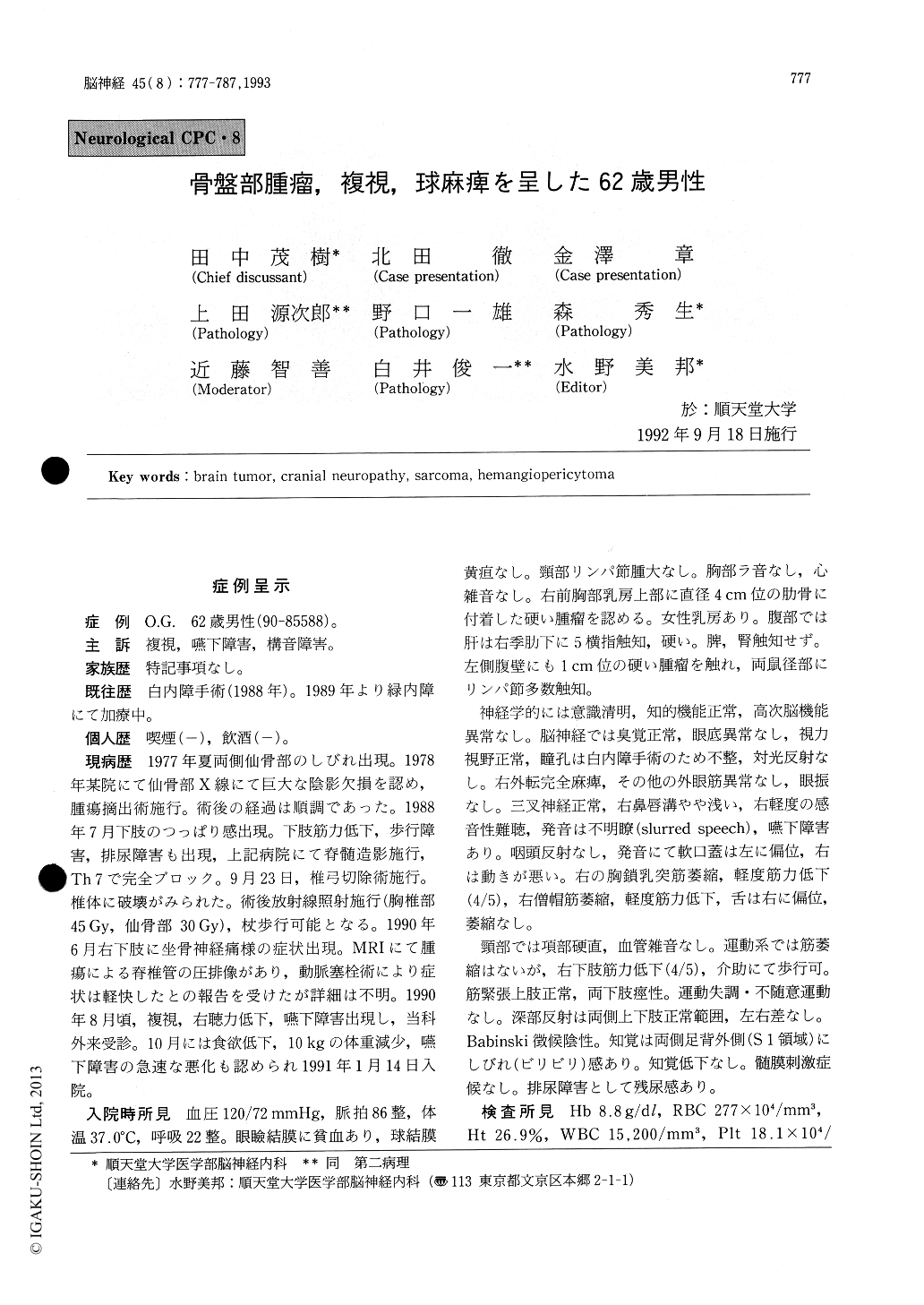Japanese
English
- 有料閲覧
- Abstract 文献概要
- 1ページ目 Look Inside
症例呈示
症例 O.G.62歳男性(90-85588)。
主訴 複視,嚥下障害,構音障害。
We report a 62-year-old man with a pelvic mass, who developed multiple cranial nerve palsies on the right side.
He was well until the summer of 1977 when he developed a numb sensation in the sacral region. In the next year, a huge tumor was found in the sacral area in another hospital. Most of the tumor wasresected at that time. Post-operative course wasuneventful. In July 1988, there was an onset of weakness in his legs, gait disturbance, and dysuria. Myelography at the above hospital revealed a com-plete block at the seventh thoracic level. He was treated by laminectomy and post-operative radia-tion. In June 1990, he developed a neuralgic pan in his right leg. Two months later, he noted diplopia, deafness in his right ear, and swallowing difficulty. He was admitted to our hospital for further work up on January 14th of 1991.
On admission, he was afebrile. General physical examination revealed a 4 cm hard mass in his rightanterior chest attaching the rib. Gynecomastia was noted bilaterally. Liver was felt by 5 cms under the right hypochondrium. The edge of the liver was firm.
On neurologic examination he was an alert and mentally sound man. His higher cerebral functions were intact. In the cranial nerves, complete palsy of the abducens nerve, mild nerve deafness, paresis of the soft palate, atrophy and weakness of the sterno-cleidomastoid and upper trapeziums muscles, all on the right side, deviation of the tongue to the right, slurred speech, and dysphagia were observed. The neck was supple. He was able to walk with a sup-port. Mild weakness was present in his right lower extremity. Both legs were spastic. No ataxia or involuntary movements were noted. Deep reflexes were symmetric and normally active. No sensory loss was observed. No meningeal signs were pres-ent.
Pertinent laboratory findings included moderate anemia (Hb 8.8g/dl), LDH 2,631U/l, CRP 7.4 mg/dl. The CSF was under an increased pressure (OP 260 mmH2O) containing 2 lymphocytes/ml, 43 mg/dl of protein, and 49 mg/dl of glucose. Radio-logic examinations revealed a destructive change in the sacrum, lytic lesions in the seventh thoracic spine and in the clivus. Cranial CT scan revealed a mass lesion extending from the nasopharyngeal region to the right cerebello-pontine angle. The tip of the pyramid was also destroyed.
His clinical course was complicated by pulmo-nary infection and DIC. Left abducens palsy also appeared. He expired on February 6, 1991.
The patient was discussed in a neurological CPC. The chief discussant arrived at the conclusion that he had a malignant hemangiopericytic meningioma arising from the sacral region with systemic metas-tases. Post mortem examination revealed a tumor originating from the retroperitoneum of the small pelvic cavity. Histological examination revealed a typical hemangiopericytoma. Metastatic lesions were observed in the liver, left adrenal gland, the skull base, and the right third rib. His multiple cranial nerve lesions appeared to be the result of compression by the metastatic tumor in the skull base which was also infiltrating the clivus. Pneumo-nia was present in the right lung.
Hemangiopericytoma is a rare sarcoma with the most frequent primary site in the retroperitoneum. In this sense, this patient had a typical site of origin. However, to our knowledge, such a huge skull metastasis has never been reported in the literature.

Copyright © 1993, Igaku-Shoin Ltd. All rights reserved.


